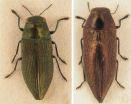(Press-News.org) This release is available in Spanish.
Scientists with the U.S. Department of Agriculture (USDA) are identifying factors that influence pesticide levels in the Chesapeake Bay airshed, including traces of "legacy" pesticides that still linger even though they are no longer being used.
Agricultural Research Service (ARS) chemists Laura McConnell and Cathleen Hapeman obtained weekly air samples and rain samples for precipitation events from 2000 to 2003 at three sites in Maryland and Delaware. Both scientists work at the ARS Environmental Management and Byproduct Utilization Laboratory in Beltsville, Md. ARS is USDA's chief intramural scientific research agency.
The samples were tested for several types of legacy pesticides, including chlordane and related chemical products such as heptachlor and breakdown products of chlordane; lindane; aldrin and dieldrin; DDT and its degradation products (DDD and DDE); and mirex. Nearly all the air samples contained lindane and chlordane products, and pesticides measured at the highest mean concentrations were dieldrin and DDE.
The scientists found that some of the legacy pesticides detected in the samples—including chlordane compounds, lindane, DDE, and dieldrin—came from local and regional sources, possibly from contaminated soils. When disturbed, the generally sandy soils on the Delmarva Peninsula are more likely to release pesticides than soils that contain higher levels of organic carbon. But the researchers also concluded that most of the lindane, heptachlor, and many of the chlordanes detected in the air samples came from sources more than 60 miles away.
Modeling results indicated that the variability in air temperature and wind conditions only accounted for 30 to 60 percent of the variability in compound levels. And there was some good news: With the exception of dieldrin, the half-life values measured for the pesticides in the samples indicated that legacy pesticide levels were decreasing over time in the Delmarva.
###
Results from this study, which support the USDA priority of promoting sustainable agriculture, were published in Science of the Total Environment and Environmental Toxicology and Chemistry.
Read more about this work in the July 2011 issue of Agricultural Research magazine.
USDA is an equal opportunity provider, employer and lender. To file a complaint of discrimination, write: USDA, Director, Office of Civil Rights, 1400 Independence Ave., S.W., Washington, D.C. 20250-9410 or call (800) 795-3272 (voice), or (202) 720-6382 (TDD).
Chesapeake Bay pesticides: Some diminish, some persist
2011-07-08
ELSE PRESS RELEASES FROM THIS DATE:
New disparity in nursing homes: Whites leave, minorities enter
2011-07-08
PROVIDENCE, R.I. [Brown University] — In the last decade, minorities have poured into nursing homes at a time when whites have left in even greater numbers, according to a new Brown University study that suggests a racial disparity in elder care options in the United States.
At first blush the analysis, published July 7 in the journal Health Affairs, suggests that elderly blacks, Hispanics, and Asians are gaining greater access to nursing home care. But the growing proportion of minorities in nursing homes is coming about partly because they do not have the same access ...
DNA decoded by FSU biologist reveals 7 new mice species
2011-07-08
After living incognito for millions of years in a remote area of a forested mountain range in the Philippines, seven newfound species of mice owe their recent discovery to DNA evidence and the Florida State University biologist who deciphered it.
What's more, the DNA drawn from the reclusive "new" mammals told FSU Associate Professor Scott J. Steppan an unusual evolutionary story. As he analyzed and compared the genetic codes of mice found in separate but proximate parts of a small area on Luzon, the largest Philippine island, he determined that while each mouse was a ...
Research shows generic medications are changing the economics of treating chronically ill patients
2011-07-08
WOONSOCKET, R.I. – July 7, 2011 – As the nation seeks to expand health care coverage to more citizens without adding burdensome costs, researchers from Harvard University, Brigham and Women's Hospital and CVS Caremark reported that preventative health care may be significantly less costly than previously thought, due to expanded use of cost-effective generic medications for the treatment and prevention of chronic disease.
A study released today in the July issue of Health Affairs concludes that preventive health care is considerably less costly than previous industry ...
NIST prototype 'optics table on a chip' places microwave photon in 2 colors at once
2011-07-08
Researchers at the National Institute of Standards and Technology (NIST) have created a tunable superconducting circuit on a chip that can place a single microwave photon (particle of light) in two frequencies, or colors, at the same time.
This curious "superposition," a hallmark of the quantum world, is a chip-scale, microwave version of a common optics experiment in which a device called a beam-splitter sends a photon into either of two possible paths across a table of lasers, lenses and mirrors. The new NIST circuit can be used to create and manipulate different quantum ...
California groundwater management trickles up from local sources
2011-07-08
In a typical year, California gets about 30 percent of its water from groundwater wells. Yet when it comes to managing this precious resource, the state of California relies on a mixed bag of more than 2,000 local water agencies with varying degrees of authority.
Critics say that this decentralized system leaves the state vulnerable to overdraft, which occurs when water is pumped out faster than replacement water is absorbed. But according to a new report published by Stanford University's Program on Water in the West, a surprising number of local water districts are ...
Graphene: What can go wrong? new studies point to wrinkles, process contaminants
2011-07-08
Using a combination of sophisticated computer modeling and advanced materials analysis techniques at synchrotron laboratories, a research team led by the University at Buffalo (UB) and including the National Institute of Standards and Technology (NIST), the Molecular Foundry at Lawrence Berkeley National Laboratory and SEMATECH* has demonstrated how some relatively simple processing flaws can seriously degrade the otherwise near-magical electronic properties of graphene.
Their new paper** demonstrates how both wrinkles in the graphene sheet and/or chance contaminants ...
Promising fire retardant results when clay nanofiller has space
2011-07-08
If materials scientists accompanied their research with theme songs, a team from the National Institute of Standards and Technology (NIST) and the University of Maryland (UMD) might be tempted to choose the garage punk song "Don't Crowd Me"* as the anthem for the promising, but still experimental nanocomposite fire retardants they are studying.
That's because the collaborators have demonstrated that the more widely and uniformly dispersed nanoscale plates of clay are in a polymer, the more fire protection the nanocomposite material provides.
Writing in the journal Polymer,** ...
Study suggests new strategy to prevent infertility, birth defects
2011-07-08
A strategy that has been shown to reduce age-related health problems in several animal studies may also combat a major cause of age-associated infertility and birth defects. Investigators from Massachusetts General Hospital (MGH) have shown that restricting the caloric intake of adult female mice prevents a spectrum of abnormalities, such as extra or missing copies of chromosomes, that arise more frequently in egg cells of aging female mammals. Their report appears in this week's online Early Edition of the Proceedings of the National Academy of Sciences USA.
"We found ...
The Brava System: How Does it Work?
2011-07-08
Brava breast enhancement is a clinically proven, nonsurgical method for enlarging your breasts. Brava utilizes tissue expansion, a method for enabling your body to grow extra skin tissue.
Brava consists of two domes with silicone gel rims that are worn over the breasts and held in place with a sports bra. A battery-powered microcomputer called a SmartBox creates and regulates a light vacuum within the domes.
This gentle tension within the domes stimulates tissue cells, causing them to multiply and generate new breast tissue. As new tissue develops, your breast size ...
Jewel beetles, obtained from local people, turn out to be 4 species unknown to science
2011-07-08
A team of researchers from the Czech University of Life Sciences discovered four new species of jewel beetles (Buprestidae) from South-eastern Asia. This family of beetles is named for their particularly beautiful body and fascinating, shiny colours.
"All new species belong to the genus Philanthaxia. Before the publication of this study, 61 species had been known from this genus. Currently, it comprises of 65 species, with a primarily Southeast-Asian distribution, except for two species extending to the Australasian region", said Oto Nakládal, a co-author of the study.
The ...



